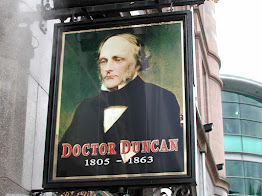William Henry Duncan, more commonly known as 'Doctor Duncan', was born in Liverpool on the 27th of January 1805 to Scottish parents, in what became the Blue Angel nightclub in Seel Street.. The nephew of James Currie, an earlier influential Liverpool physician renowned for his treatment of fevers, he was also the nephew of Henry Duncan of Ruthwell and received his early education in Scotland under Henry Duncan's protection. William qualified as a medical doctor in Edinburgh and, returning to Liverpool to work, set up a general practice, living at 54 Rodney Street. He was a physician at Liverpool's Northern Hospital from 1837 to 1838 and at Liverpool Infirmary from 1843 to 1848.
In the 19th century, Liverpool was the second largest port and
commercial centre in the UK, a vibrant city attracting many
people to its shores. However with the introduction of seafarers and
immigrants also came infections, such as tuberculosis, typhus and cholera, and with many thousands of Liverpool’s inhabitants crowded into airless
cellars and small squalid rooms, these infections quickly spread among
the poverty stricken.
In 1846 the passing of the Liverpool Sanitary Act led to William's appointment as the town’s Medical Officer of Health on the 1st of January 1847. This was the first of this type of Senior Government role of its kind in the country with London not following suit until the mid 1850s. He had the unanimous backing of the Health Committee due to his perseverance in making public bodies aware of the importance of sanitation and had no hesitation in taking up their invitation. The position was a part time one, with a 'quiddamm honorarium' of £300 a year being paid, meaning he could continue his private practice and consultancy roles with the Infirmary and dispensaries. He set about his task keenly, advising the Health Committee in March of that year of ways to combat typhoid fever. Amongst his recommendations were more frequent litter collections, the washing of walls with quick lime, and that clothes of infected people should be taken to wash-houses.
In January 1848 the Council made a decision to give William £750 per year to devote all his time to the Corporation and to give up his private practice. The recommendations he had made the previous year with respect to hygiene quickly paid off, with 1907 dying of disease in the second quarter of 1848 compared to 4809 in the corresponding period the previous year. He showed the link between the common water taps and cases of cholera in 1854 and worked closely with James Newlands, the Borough Engineer, to identify the areas where sanitation needed improving, using figures he had collated on disease to justify the need for drainage and sewerage improvements. He also raised concerns over the prevailing practice of burying in pits with Graveyards impregnated with decaying animal matter contaminating the atmosphere and likely to injure health. In summer time more than 100 bodies were collected together in an open pit in all stages of decomposition, some lain there for 2 months.
In 1863, after devoting so much time to saving others, William's own health was failing and he was unable to perform his duties, with Dr Cameron standing in for him. There was no immediate cause for concern though when he visited relatives in Elgin in May, however he died suddenly on Saturday the 23rd of May 1863 and Dr William Stewart Trench was appointed as his successor. By 1890 the average general death rate of Liverpool was declared by Sir John Simon to have been reduced by 'probably at least a fourth part' of the rate which prevailed when 'Dr Duncan' had become medical officer of health.
 |
| Blue Angel Club site |
 |
| Cains Pub, St John's Lane |
Dr Duncan’s legacy lives on today with The William Henry Duncan Building, whose entrance is off West Derby Street, housing the Institute of Ageing and Chronic Disease, research groups from the Institute of Translational Medicine and the Liverpool Biobank. Also a pub, opened by Cains Brewery in 1999 is named in his honour in St John’s Lane, Liverpool while there are also plaques commemorating him at 54 Rodney Street and at the Blue Angel.
see also:- http://www.thefootballvoice.com/2020/10/liverpool-exemplar-jean-davies.html

No comments:
Post a Comment